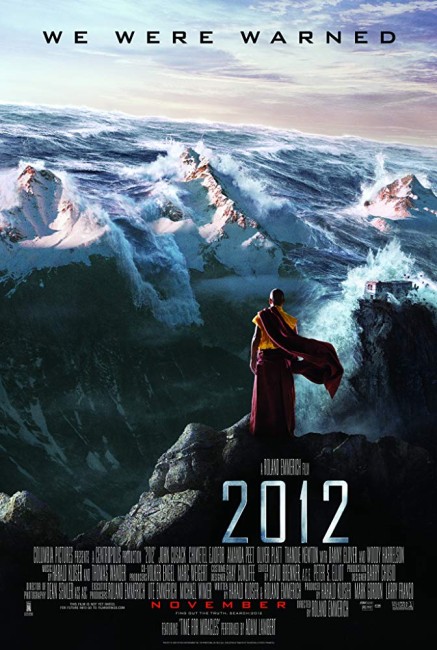Crew
Director – Roland Emmerich, Screenplay – Roland Emmerich & Harald Kloser, Producers – Larry Franco, Mark Gordon & Harald Kloser, Photography – Dean Semler, Music – Harald Kloser & Thomas Wander, Visual Effects Supervisors – Volker Engel & Marc Weigert, Visual Effects – Digital Domain (Supervisor – Mohen Leo), Double Negative (Supervisor – Alex Wuttke), Hy*drau*lx (Supervisor – Chris Wells), Pixomondo (Supervisor – Rainer Gombos), Scaline VFX (Supervisor – Stephan Trojansky), Sony Pictures Imageworks (Supervisor – Peter Nofz) & Uncharted Territories, Special Effects Supervisor – Mike Vezina, Production Design – Barry Chusid. Production Company – Columbia/Centropolis.
Cast
John Cusack (Jackson Curtis), Chiwetel Ejiofor (Adrian Helmsley), Oliver Platt (Carl Anheuser), Amanda Peet (Kate Curtis), Thandie Newton (Laura Wilson), Danny Glover (President Thomas Wilson), Tom McCarthy (Gordon Silberman), Woody Harrelson (Charlie Frost), Liam James (Noah Curtis), Morgan Lily (Lilly Curtis), Zlatko Buric (Yuri Karpov), Blu Mankuma (Harry Helmsley), George Segal (Tony Delgatto), Jimi Mistry (Dr Satnam Tsurutani), Beatrice Rosen (Tamara), Johann Urb (Sasha), John Billingsley (Professor West), Chin Han (Tenzin), Osric Chau (Nima), Stephen McHattie (Captain Michaels), Henry O (Lama Rinpoche), Lisa Lu (Grandmother Sonam), Alexandre Haussmann (Alec Karpov), Philippe Haussmann (Oleg Karpov), Patrick Bauchau (Roland Picard), Chang Tseng (Grandfather Sonam)
Plot
In 2009, a friend takes US geologist Adrian Helmsley into a mine deep underground in India. There Helmsley sees evidence that freak conditions caused by planets across the Solar System coming into alignment is causing the sun to emit high quantities of abnormal neutrinos that are having the effect of drastically raising the temperature of the Earth’s crust. Helmsley rushes to the US government with this information and The President begins to make plans with other countries. In 2012, unsuccessful science-fiction writer Jackson Curtis goes camping in Yellowstone National Park with his children and they enter a site cordoned off by the military where Helmsley is taking readings. There Jackson meets the crackpot Charlie Frost who runs a radio show where he broadcasts about conspiracy theories. He tells Jackson that he has a map to the lifeboats that governments have built to escape the coming catastrophe. As Jackson realises that something is happening, he hurriedly evacuates his ex-wife and children from California just as massive earthquakes devastate the area. Soon massive earth upheavals and volcanic activity are ravaging every landmass in the world. Following Charlie’s map, Jackson and the others attempt to get to China where the governments of the world have built a series of arks in secrecy so that a selected and paying few can survive. Trekking into the Himalayas, Jackson and his party try to find a way to get aboard the arks before giant-sized tsunamis sweep across the surface of the Earth.
German-born Roland Emmerich has gained a reputation as a director who loves spectacle and disaster. During the 1990s, Emmerich’s massively successful Independence Day (1996) was at the forefront of the disaster movie’s finding a renewed life via the new CGI effects technologies. Emmerich has remained a spectacle-driven A-list director since then with bigger and bigger special effects vehicles such as Godzilla (1998), The Day After Tomorrow (2004) and 10,000 B.C. (2008). (A full list of Roland Emmerich’s genre films is at the bottom of the page). Emmerich’s good points and bad points are writ large throughout these. His forte is special effects, spectacle and blowing things up, especially familiar landmarks. His weakness is wooden characters, bad dialogue and plots that seemed assembled out of old science-fiction cliches. These are fairly much the things that one must accept about any Roland Emmerich film.
Roland Emmerich has remained a science-fiction director fairly much since the start of the 1990s. On the other hand, Emmerich has a strong preponderance towards wacky pseudo-science such that one should perhaps more correctly identify him as a Fringe Science Science-Fiction director. Both Stargate (1994) and 10,000 B.C. come informed by the theories of Erich von Daniken, a Swiss fraudster who wrote a series of books wherein he claimed that aliens had come to Earth in prehistory and influenced the building of ancient monuments. Independence Day takes the Roswell Incident and Area 51 beloved of UFO conspiracies as a factual given. The Day After Tomorrow was based on a non-fiction book by Whitley Strieber, the horror author who claimed to be abducted by aliens, and Art Bell, the host of a radio program about the paranormal, wherein they made claim that freak weather events had destroyed advanced ancient civilisations. Emmerich’s subsequent Anonymous (2011) takes a series of academic crank theories about William Shakespeare not being the author of his own plays as an historical given.
In the dvd extras for 10,000 BC and on the end credits of 2012, Emmerich admits a debt of inspiration to Fingerprints of the Gods (1995), a non-fiction book by British paranormal and fringe science writer Graham Hancock. Hancock’s claims, which serious archaeologists and historians have derided, are that in prehistory there existed a highly scientifically advanced society located in Antarctica. Hancock claims that this society was wiped out by a Crustal Displacement, caused by a shift of the location of the Earth’s poles, but that remnants of their advanced knowledge continued among subsequent ancient civilisations.
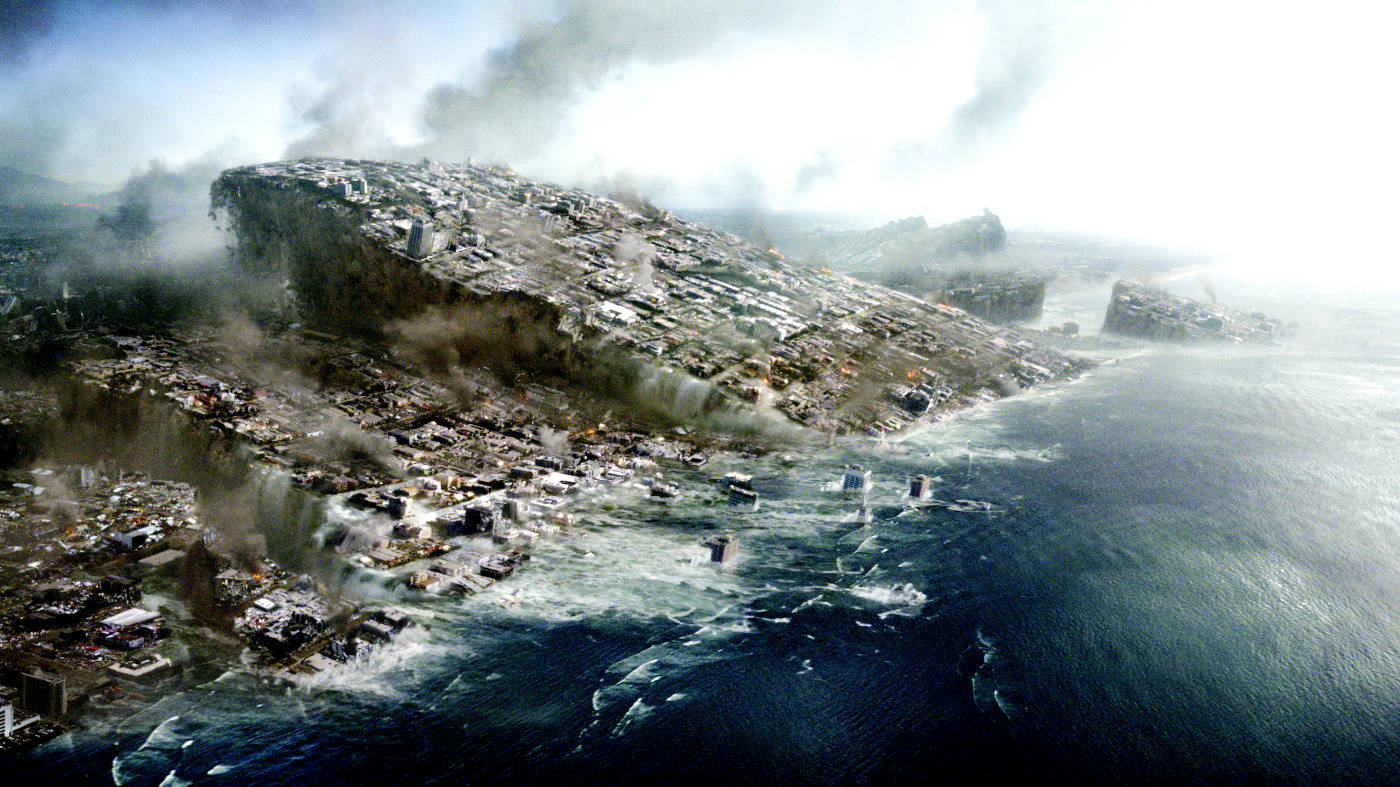
Of course, the biggest piece of pseudo-science that 2012 taps into is the nonsense that surrounded its very title date – that according to the Mayan calendar the world was going to end on December 21, 2012. This idea was first popularised by New Age writer Jose Arguelles in his books The Transformative Vision: Reflections on the Nature and History of Human Expression (1975) and The Mayan Factor: Path Beyond Technology (1987). According to Arguelles’s interpretation, the Mayan Long Count Calendar is counted in baktun (periods of around 394 years) that measure the cycles of time since the beginning of the world. The world is periodically destroyed and recreated by the Mayan gods every few baktun, of which the thirteenth one would end on December 21, 2012. For Arguelles, this was part of his Harmonic Convergence, which was caused by the planets of the solar system coming into alignment and would culminate in the destruction of our current way of life, followed by the spiritual rebirth of human consciousness as the fourteenth baktun began.
Other authors subsequently took up this idea, most notedly US writer John Major Jenkins who specialised in Mayan prophecy and pseudo-archaeology. In Maya Cosmogenesis 2012: The True Meaning of the Maya Calendar End-Date (1998), Jenkins claimed that the Mayans had advanced astronomical knowledge that allowed them to predict a coming galaxy-wide alignment that corresponded with the beginning of the Age of Aquarius. One of the possibilities was that this alignment would end up creating enormously powerful black holes that would have a devastating gravitational influence on the Earth.
An enormous number of theories grew out of these two authors, which tended to swing between New Age mystical awakening and alarmist end of the world scenarios. Others have thrown supposed prophecies from Nostradamus and The Bible into the mix as well. These have been popularised by the normally reputable US History Channel in a surprising number of documentaries that luridly spelled out 2012 disaster scenarios. It should be said that any idea of mystic events or the end of the world occurring in 2012 were denied by serious historians of Mayan culture who stated that interpretations were often contradictory and that the original texts did not specify anything as happening.
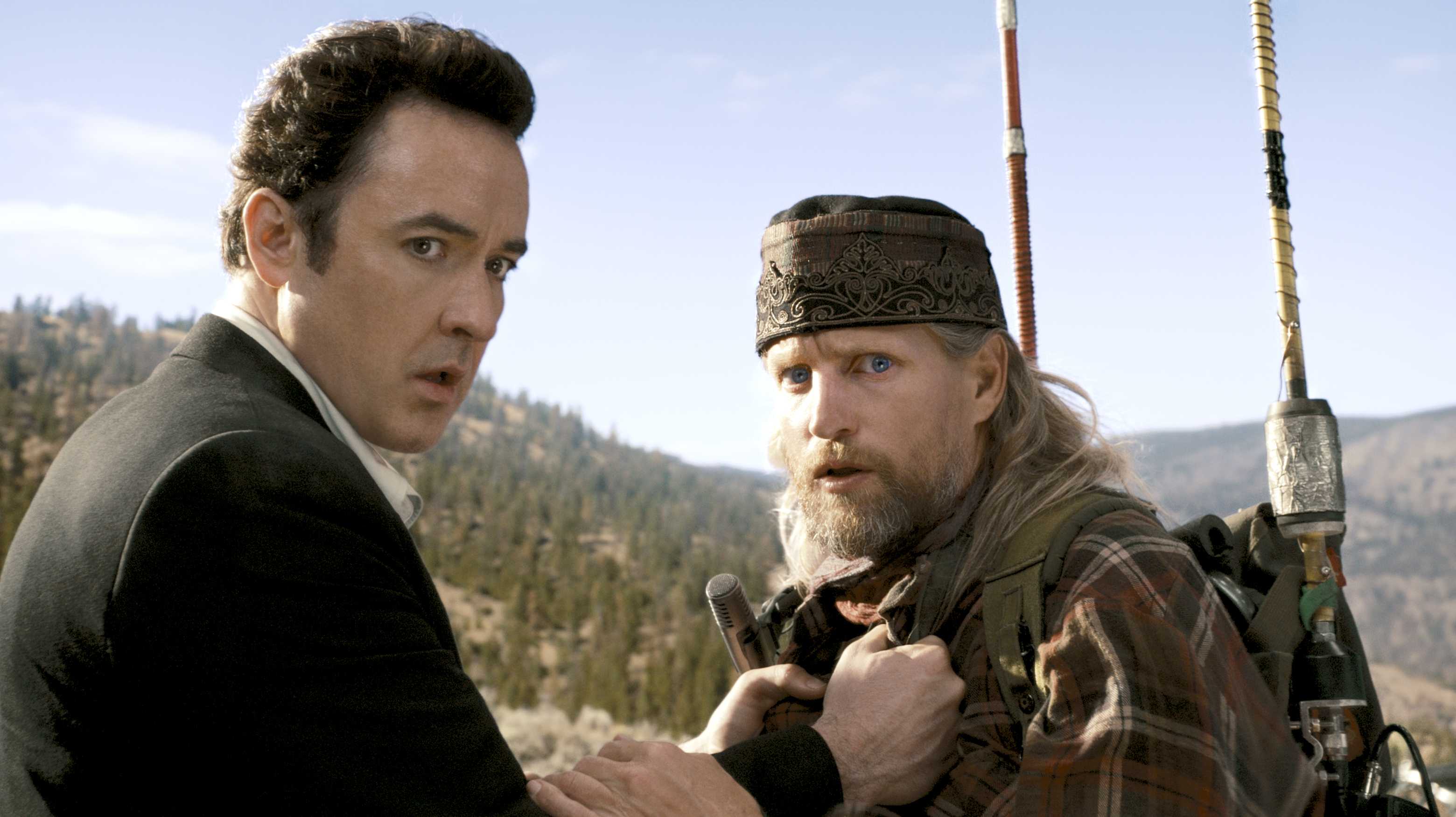
To 2012‘s credit, this pseudo-archaeological mysticism features relatively little in the film. We see planets coming into alignment at the start. There are a couple of references to the Mayans from Woody Harrelson’s wacky radio host and a brief tv clip of a Mayan Doomsday cult, but that is about it. It could perhaps be argued that the film’s climaxing on a note of renewal taps into the idea that 2012 will be the birth of a new age when human consciousness changes towards one of peace and mutual cooperation. However, you get the feeling that the film called itself 2012 in order to capitalise on the mystery and fascination surrounding the date and then Roland Emmerich went away and did his usual thing blowing landmarks up. Indeed, Emmerich has taken more from Graham Hancock’s Crustal Displacement theories than he has from Arguelles and Jenkins’ claims. I went in expecting a film that delved into its Mayan mysticism with John Cusack running around akin to Tom Hanks in The Da Vinci Code (2006) and piecing together sudden insight into secret knowledge of the world as civilisation comes crumbling down around his shoulders. In fact, such is not the case at all – 2012 is a plain end of the world/disaster movie and Mayan Long Count Calendar prophecies prove to be of little significance to what is going on.
I once coined the term Disaster Porn for the modern CGI effects driven brand of films that specialise in scenes of spectacular mass destruction. See the likes of Twister (1996), Dante’s Peak (1997), Titanic (1997), Armageddon (1998), Deep Impact (1998), War of the Worlds (2005), Poseidon (2006), Transformers (2007), Knowing (2009) and most of the rest of Roland Emmerich’s work. Disaster Porn is intended in exactly the same way that the term Torture Porn is – of films that offer up mass destruction and the vast loss of human life for our vicarious thrill. Both Torture, Disaster (and indeed regular) Porn films are centred around the provision of certain types of novelty set-pieces every few minutes. The human characters are often regarded as secondary fodder and are only there to meet gruesome deaths. What it must be said is that if disaster movies can be alikened to porn, then Roland Emmerich is surely a John Holmes of the genre. This is the man who does it the biggest and conducts everything on a far more stupendous scale than anybody else does.
2012 has been almost entirely designed around stunning mass destruction effects sequences – scenes with John Cusack driving a limo through the streets of L.A. and then taking off in a small plane as chasms open up and buildings collapse around them; the similar flight from Las Vegas in the Russian transport plane; the party fleeing as a massive-sized volcanic discharge erupts in Yellowstone National Park and starts raining magma down around them; an entire cruise liner being turned upside down by a tsunami; sections of city sliding into the ocean; the bizarre image of the White House being destroyed by an aircraft carrier upturned by a tidal wave; tsunamis obliterating whole landscapes, even rampaging through the peaks of the Himalayas.
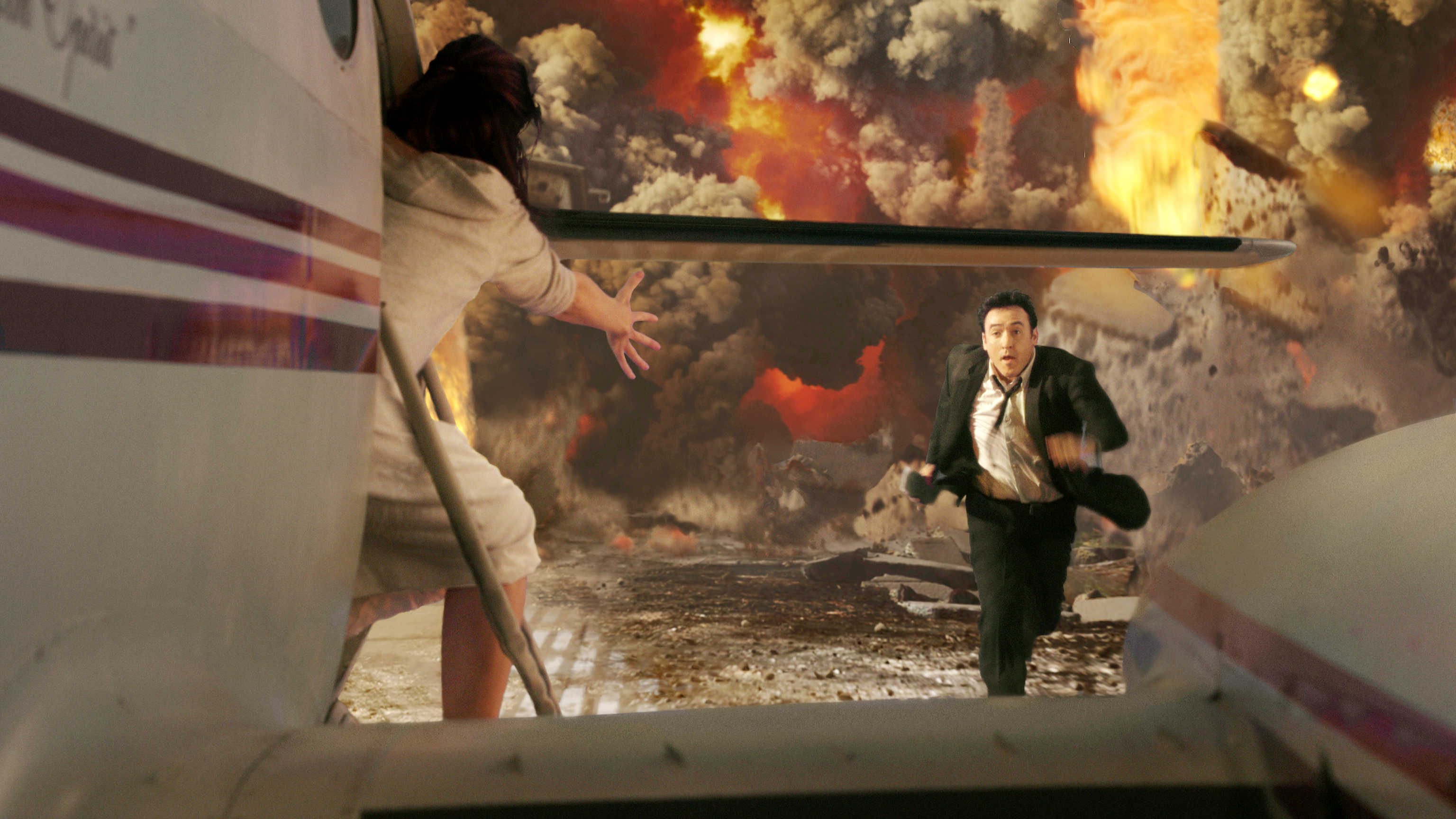
Often the pieces of plot that connect these set-pieces together are thin – John Cusack has to land at Yellowstone and then take a campervan up the top of a mountain to ask Woody Harrleson a question, just as the ground happens to erupt while he is there (quite why Harrelson has set up his home and a radio station in the midst of a National Park is never explained either); planes are constantly running out of fuel necessitating dangerous touchdowns. The trail that John Cusack persuades his family to follow all the way to China seems specious guesswork at best. What you cannot deny however is that the spectacle and the extraordinary detail that the visual effects people put into all of this mass destruction is an absolute work of art in itself.
Roland Emmerich manages to throw in every conceivable form of disaster imaginable – volcanoes, earthquakes, tsunamis, plane crashes, the overturning of a cruise-liner a la The Poseidon Adventure (1972). It is almost as though he has thrown as many disasters as he could think of together into a single film to try and see how big he could make it, in effect issuing a challenge to see if anybody could ever subsequently outdo him. Even when the cast make it into the ark, which in any lesser film would be the climax of the show, Emmerich contrives yet another drama about John Cusack having to make a suicide dive to free a cable lest the ship crash into the side of Mount Everest. The scenes unveiling the arks and the drama with the masses abandoned outside have been borrowed directly from When Worlds Collide (1951) – for that matter, 2012 could almost read as an earthbound version of When Worlds Collide minus the two roving planets. You half suspect that Roland Emmerich has set out in determination to trump Stephen Sommers who has been threatening to remake When Worlds Collide over the last few years.
For all the overblown, laughable and wooden comments it attracted in the mainstream press, I liked 2012. Roland Emmerich seems to be getting better with characters and at least allows his actors to give them more life than usual. What I also liked is that even though he is creating a Disaster Porn spectacle that is putting on mass destruction and copious loss of life for our edification, Emmerich pushes an attitude of responsibility towards it all. Some random deaths occur but there is always sadness and regret expressed at the loss of life. When there are people endangered, Emmerich focuses on the fight to leave no one behind rather than others being concerned for individual survival. Not even the self-interested villains get deservous fates. There is a surprising message throughout about how the way we confront cataclysmic events must be something that is about our dignity and humanity rather than survival at all costs.
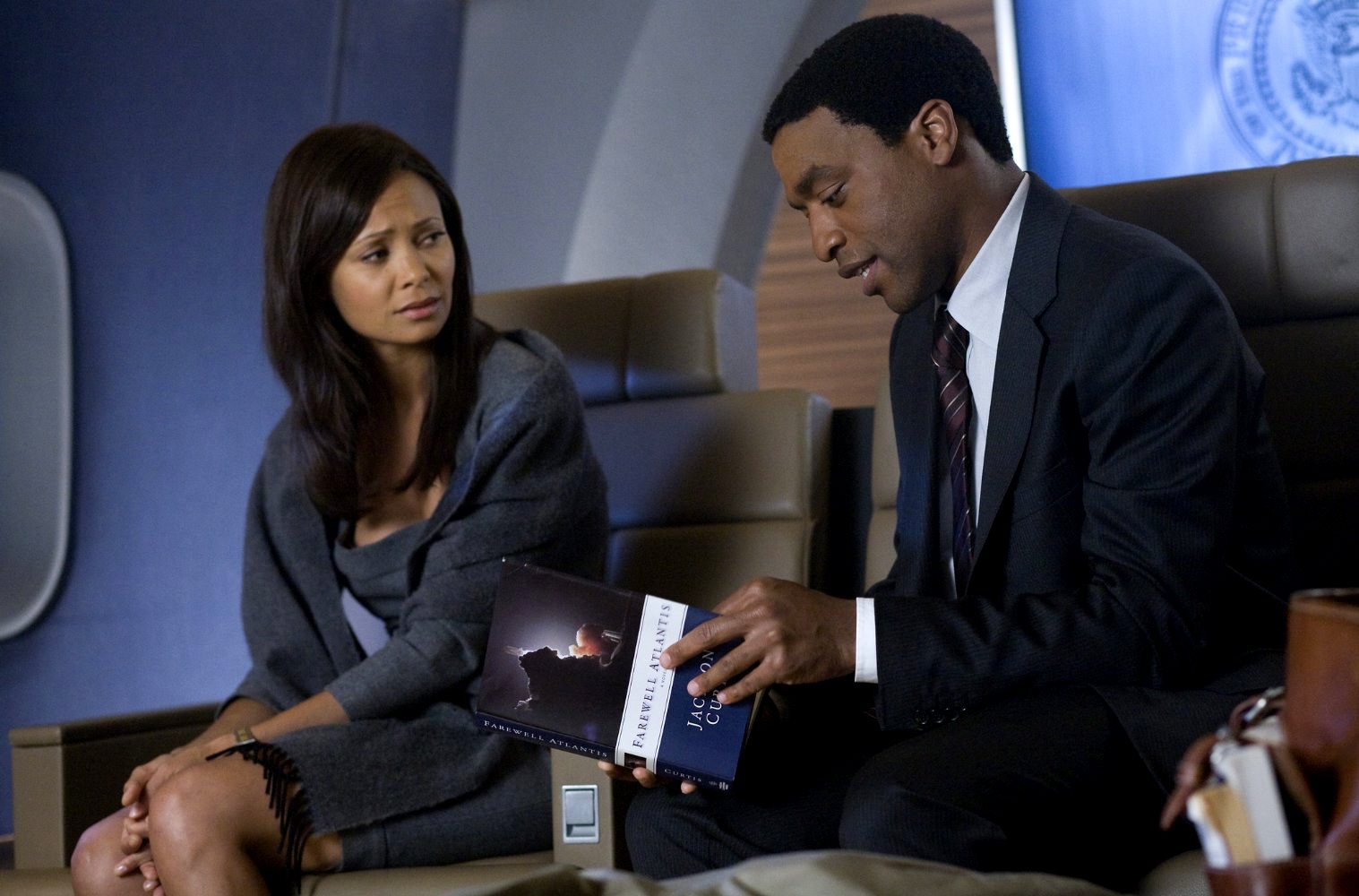
In his earlier films – Independence Day and The Patriot (2000) – Roland Emmerich seemed lost in the flag-waving values of his adopted country the USA, as though as an outsider he had to overcompensate to fit in by making red-blooded patriotic films showing American guts, glory and sacrifice winning out over a clearcut and unambiguous enemy. Interestingly, on the other side of the 00s, Emmerich’s films have swung from Republican recruiting commercials to a well-honed liberal instinct. The Day After Tomorrow was one of the first films to take up the issue of Global Warming – even predating An Inconvenient Truth (2006) – and the first film to be made using renewable resources, while the Emmerich-produced Trade (2007) tackled the global root causes of people trafficking and his subsequent film Stonewall (2015) depicted the beginning of the US gay rights movement.
2012 continues Roland Emmerich’s newfound liberal bent. Indeed, while Independence Day seemed like a rehearsal for the George W. Bush presidency, 9/11 and the Iraq War, 2012 firmly establishes itself as a film that wholeheartedly backs the Obama White House. The climactic drama the film hangs on is one where Chiwel Ejiofor (who is cast as being young, academic, idealistically principled and Black, not to mention touts the value of a book that naively believes in hope ie. could easily stand in for Obama himself) stands up against Oliver Platt’s de facto President and challenges Platt’s attitude that the political and financial elites have the right to survive at the sacrifice of the lives of ordinary people. The scene even has Chiwel Ejiofor’s Obama stand-in calling all the other world leaders on the line to drum up a group condemnation of Oliver Platt’s self-interested actions. In other words, it is like Roland Emmerich celebrating the passing of the old guard of the unilateralist, self-interest driven neocon school and jumping aboard the multi-national, multilateral and cooperative worldview that looks to the survival of all, not just oneself and friends and those with financial influence.
Roland Emmerich’s other films are The Noah’s Ark Principle (1984), Making Contact/Joey (1986), Ghost Chase (1987) and Moon 44 (1990), all made in his native Germany. Emmerich then had a big breakthrough in the West with Universal Soldier (1992) and subsequently began to specialise in lavish effects-driven spectacle with the likes of Stargate (1994), Independence Day (1996), Godzilla (1998), the non-genre American War of Independence film The Patriot (2000), The Day After Tomorrow (2004), 10,000 BC (2008), the non-genre Anonymous (2011) about the historical conspiracy over the authorship of Shakespeare’s plays, the action film White House Down (2013), the true-life gay rights drama Stonewall (2015), Independence Day: Resurgence (2016), the war film Midway (2019) and the disaster movie Moonfall (2022). Emmerich has also produced The High Crusade (1994), the tv series The Visitor (1997), The Thirteenth Floor (1999), Eight Legged Freaks (2002), Hell (2011) and The Colony (2021).
(Nominee for Best Special Effects at this site’s Best of 2009 Awards).
Trailer here

